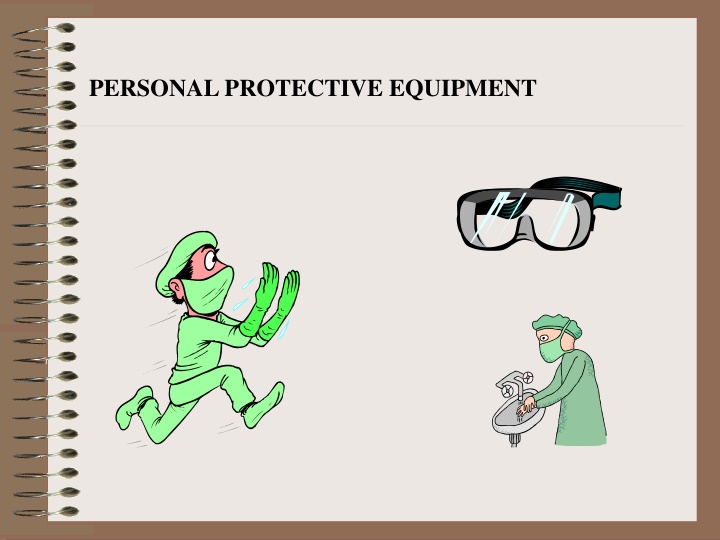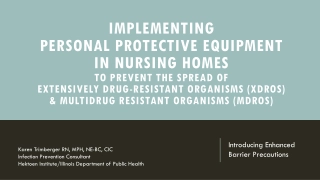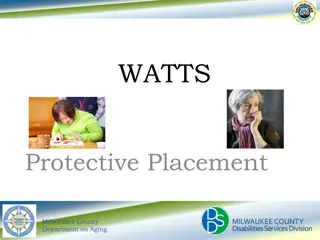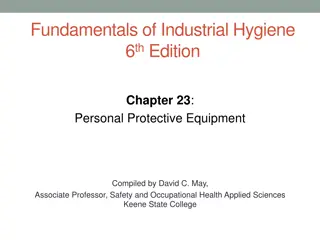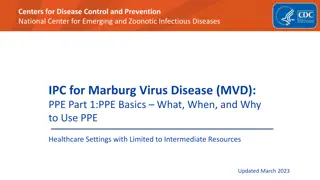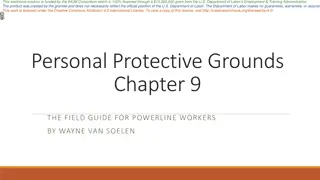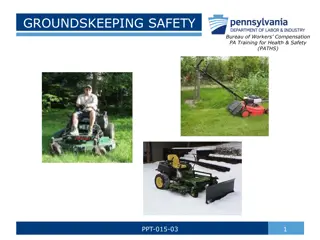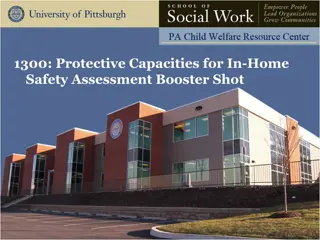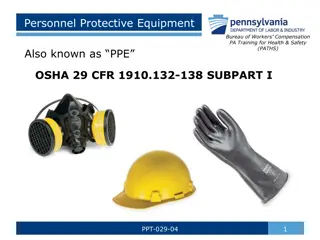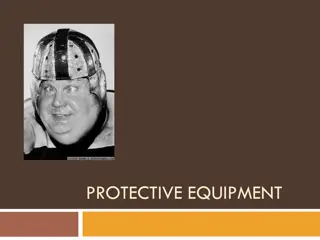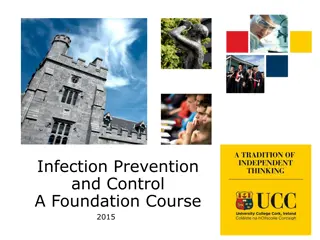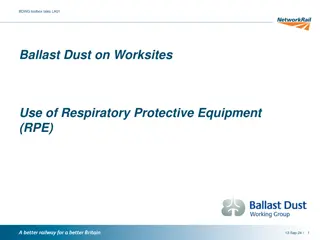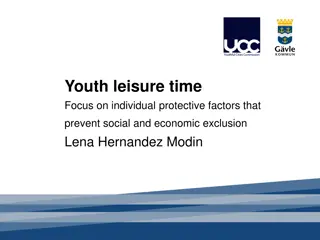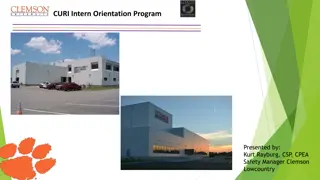PERSONAL PROTECTIVE EQUIPMENT
Establishing early in the AIDS epidemic, the use of personal protective equipment (PPE) is crucial to prevent the transmission of microorganisms from one person to another. PPE should be worn at all times and disposed of properly to maintain safety in healthcare settings.
Download Presentation

Please find below an Image/Link to download the presentation.
The content on the website is provided AS IS for your information and personal use only. It may not be sold, licensed, or shared on other websites without obtaining consent from the author.If you encounter any issues during the download, it is possible that the publisher has removed the file from their server.
You are allowed to download the files provided on this website for personal or commercial use, subject to the condition that they are used lawfully. All files are the property of their respective owners.
The content on the website is provided AS IS for your information and personal use only. It may not be sold, licensed, or shared on other websites without obtaining consent from the author.
E N D
Presentation Transcript
I. Standard Precautions of microorganisms from one person to another 1. Established early in the AIDS epidemic 2. Prior to the diagnosis of AIDS, PPE was used only in identified infectious process. (Once AIDS was better understood, PPE was universally applied to all patients) A. Equipment and methods that prevent the transmission
B. These are applied to all patients/residents at all times because not all diseases are readily observable. should be washed for a minimum of 10 seconds and gloves changed when moving from one patient to another 1. Gloves should be worn at all times; hands
2. Depending on the activity performed on the patient, the nature of the patient s illness, and the amount of exposure to blood and the amount of exposure to blood and body fluids, other PPE should be worn. coughing, bleeding or has drainage from wounds or body orifices a. Gown and goggles if patient is
4. All sharps (needles, razors, etc.) should be disposed of immediately in biohazardous puncture proof sharps containers located in each room.
5. Never carry needles or sharps from one location to another. If necessary, to do so, never point toward another person or yourself. KEEP POINT TOWARD THE FLOOR OR CEILING.
6. All unknown spills or waste should be treated as potentially hazardous.
C. Involves the following: 5. Cap 6. Handwashing 7. Methods for handling human waste, spills and labeling of hazardous substances 1. Gloves 2. Mask 3. Goggles 4. Gowns
D. Transmission-based precautions 1. Airborne a. Diseases that are spread through the air b. Examples include chickenpox, measles, TB
2. Droplet a sneeze or cough b. Examples include certain types of meningitis, pneumonia, pertussis, influenza, mumps, German Measles a. Diseases spread by droplets, as in
3. Contact skin or objects a. Diseases spread by contact with infected diphtheria, scabies, AIDS, MRSA b. Examples include herpes, impetigo,
4. Reverse or Protective Isolation a. This concept is the opposite of every other transmission-based precaution resident from any infectious process carried by the health care providers or the public b. It involves protecting the patient/ cancer chemotherapy patients c. Necessary for patients with immune deficiency/suppressed systems: AIDS patients, transplant patients,
E. How airborne precautions work patients have the same disease 1. Patient s room must be private unless both equipment 2. Room may have special ventilation 3. The door of the room must remain closed 4. Staff and visitors must wear masks
contact with the patient, it is advisable to wear gloves, gown , hair covering depending on the activity 5. If staff has more direct prolonged as possible and wear a mask if they do leave 6. Patients should leave the room as little
F. How droplet precautions work more than three feet 1. Similar to airborne, but droplet travels no people with same disease 2. Therefore room should be private or 3. If patients with different diseases are placed in the same room, they should be separated by at lease three feet
4. Staff and visitors within three feet of patients need to wear masks. with the patient, it is advisable to wear gloves, gown, hair covering, goggles, depending on the activity. 5. If staff has more direct prolonged contact possible and wear masks when they leave 6. Patients should leave the room as little as
G. How contact precautions work diseases together 1. May be private or have people with same gloves and change them whenever soiled 2. Everyone entering the room must wear 3. Gowns, mask, goggles, hair covering, should be worn depending on length of contact and activity objects before leaving the room 4. All must wash their hands and avoid touching
5. Patients should leave the room as little as possible and avoid contact with other people or objects of any trash or items leaving the room 6. Use biohazardous waste bags to dispose pressure equipment should remain in the room, and disinfected properly when precautions have been discontinued 7. Equipment such as thermometer ,blood
H. Reverse Isolation necessary equipment to prevent exposing the compromised patient to any microorganisms 1. The health care provider puts on any care that is to be given 2. The equipment is determined by the
II. Exposure i.e. HIV, the exposure must be reported to the supervisor of the unit A. Should a known exposure occur to a microorganism B. An incident report must be completed cleaned with an antiseptic solution, and if necessary, appropriate blood tests should be completed. C. Depending on the exposure, the area should be
D. Follow-up must be done as required by policy (either facility or CDC) III. Application of personal protective equipment according to protocol A. Hands must be washed prior to application, B. This equipment is clean, not sterile
C. Order of application 1. Gown 2. Cap 3. Mask 4. Gloves sterile gloves might be required depending on what care is to be given (e.g. assisting with some sterile procedure)
D. Order of Removal of the glove 1. Gloves first by never touching the outside cap off 2. Hook the finger inside the cap and pull pulling the gown off and touching only the inside of the gown; roll it inside out as removing 3. Reach behind the gown and untie,
4. Finally pull ties of mask and remove, being careful to avoid touching hair should be removed just before leaving the room ( or if there is an outside foyer for application and removal of PPE it should be removed there) 5. In airborne transmission, the mask 6. Lastly, hands should be washed according to protocol
7. When removing equipment, all should be placed in the proper biohazardous container 8. When biohazardous containers are full, they should be removed from the patient s room t double bagging. Two people should do this -one on the inside of the room, one on the outside to receive the contaminated items and help place them in the proper protective bags. The person inside the room only touches the inside of the receiving biohazardous bag; the person outside the room only touches the outside of the receiving biohazardous bag
